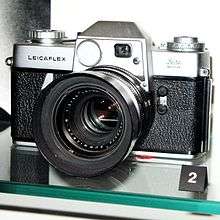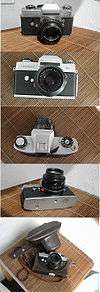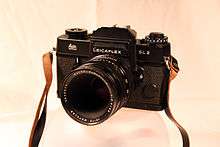Leicaflex / SL / SL2
 | |
| Overview | |
|---|---|
| Type | 35 mm SLR camera |
| Lens | |
| Lens mount | Leica R-mount |
| Focusing | |
| Focus | manual |
| Exposure/Metering | |
| Exposure | manual |
| Flash | |
| Flash | hot shoe |
The Leicaflex was the first series of 35mm single-lens reflex (SLR) cameras manufactured by Leitz. The Leicaflexes were fully mechanical cameras marketed between 1964 and 1976, in response to the rapid increase in popularity and usability of SLRs during this period. Their appeal was limited by their failure to keep pace with the state of the art in SLR design, their somewhat limited selection of accessories, and their extremely high price in comparison with their Japanese competitors. They were ultimately replaced by the R series Leicas developed by Leitz with the assistance of Minolta under a cooperation agreement between the two companies.
Development
Leitz was a reluctant entrant into the SLR market. At the beginning of the 1960s, the only still cameras manufactured by Leitz were 35mm rangefinders, a camera design that its Japanese competitors, most notably Nippon Kōgaku (Nikon), were beginning to abandon in favor of SLR designs. The company's management continued to believe in the inherent advantages of the rangefinder design over the SLR, but in view of the steady shift in market share from rangefinders to SLRs such as the Nikon F, the Asahi Pentax and the SR-series Minolta in the early 1960s, and the increasing prominence of high quality SLR cameras among professional photographers, it had little choice but to offer an SLR of its own. To compete in this market Leitz introduced an expensive SLR, called Leicaflex. Nowadays, this first Leicaflex model is generally referred to as the Original Leicaflex or Leicaflex Standard to distinguish it from the models that followed. Colloquially it was referred to early on as the 'diesel Leica'.
The Leicaflex lacked a few features present in the most advanced products of its time. It has been much criticized for omitting a through the lens (TTL) exposure meter of the type which had previously been incorporated into the Topcon RE Super and the Asahi Pentax Spotmatic, and which would soon appear in the Nikon F Photomic T, Canon Pellix and a number of other reflex cameras. It also lacked the interchangeable viewfinders offered for the Miranda, Canon Canonflex, and Nikon F. Finally, the original Leicaflex featured a finder which, while offering a very bright aerial image, was not full focusing, offering only a small focusing zone at the center. The Leicaflex did offer mirror lock-up, and shutter speeds up to 1/2000 visible in the finder.
The camera introduced a new three lug bayonet mount. This mount remains substantially unchanged to the present day, although the mount has been developed in order to accommodate increased levels of automation. Leica had always offered a more limited range of reflex lenses than its Japanese rivals; at the time of the introduction of the Leicaflex, the range was limited to 35mm, 50mm, 90mm and 135mm focal lengths of moderate speed.
The original Leicaflex is readily identifiable from its CdS meter window and battery cover on the front of the prism housing just above the lens. It was offered in chrome and black enamel finishes, the latter being rare. The first series had a fan-shaped exposure counter window and a tripod socket attached by three screws, whereas the second series had a round exposure counter window, a tripod socket integrated in the bottom plate and a meter switch built in the advance lever. In use, the two series are virtually identical. 32,500 serial numbers were allotted to the original Leicaflex.[1]
Accessories
- Motor drive for the Leicaflex SL Mot and SL2 Mot, named Leicaflex Motor
- Eveready case 14557
- Eveready bags
Leicaflex SL
 | |
| Overview | |
|---|---|
| Type | 35 mm SLR camera |
| Lens | |
| Lens mount | Leica R bayonet |
| Focusing | |
| Focus | manual |
| Exposure/Metering | |
| Exposure | manual |
| Flash | |
| Flash | cold shoe |
| Shutter | |
| Frame rate | 3fps with motor (SL Mot) |
The Leicaflex SL was an SLR made by Leitz from 1968 to 1974 as the second iteration of the Leicaflex series.
In 1968, Leitz responded to the critics of the non-TTL meter of the original Leicaflex by introducing its successor the Leicaflex SL with a TTL meter. The SL designation in the name was an abbreviation of "Selective Light", the name chosen by Leitz for its implementation of TTL metering. This system metered a limited area represented by the viewfinder's central microprism spot. At a time when SLR manufacturers were divided between those embracing TTL metering at full aperture (such as Nikon and Konica), and those with mounts which permitted only stop-down metering (such as Pentax and Canon), Leitz chose to implement full aperture metering on the Leicaflex SL.
Light measurement was by a cell mounted in the camera base pointing upwards with light directed onto it by a small secondary mirror hinged from the main mirror, the central portion of the main mirror being semi silvered. A similar arrangement was used in every successive R camera.
Leitz also addressed complaints about the original Leicaflex focusing screen in the SL focusing screen, which offered a ground-glass focusing screen with a central microprism spot. This more conventional configuration did not prevent it from being very bright and comfortable.
The Leicaflex SL replaced the mirror lock-up function of the original Leicaflex with a depth of field preview. The principal effect of this change was to obsolete the rangefinder-derived 21mm f/3.4 Schneider Super-Angulon lens which, due to the protrusion of the rear element into the camera body, was designed to work with the mirror locked up in conjunction with an external viewfinder. This lens cannot be mounted on the SL or its followers without mirror lockup. The original Leicaflex Super-Angulon was replaced by the retrofocus type 21mm f/4 Super-Angulon-R, which can be mounted in the conventional way.
The Leicaflex SL is identifiable by the letters "SL" on the front of the prism housing, which replaced the meter window and battery cover of the original Leicaflex. It was offered in chrome as well as black finish. Black SLs initially bore a black enamel finish, which was subsequently replaced by a more durable "black chrome" finish. 70,995 serial numbers were allotted to the Leicaflex SL.[2]
In 1972, for the Olympic Games in Munich, an edition of 1,000 was made in chrome with special markings (the five rings, the year 72 and a three digit number).[3]
Some Leicaflex SL for the US Navy were engraved NAVY on the bottom plate.[4] They are reported at least in black enamel and black chrome.
On occasions, you can find a dummy Leicaflex SL with a dummy 50mm f/2 Summicron standard lens. This was a display object and demonstration model for retailers, and is called 'Attrappe' in German, which means 'mockup.' They did not have a serial number.

Leicaflex SL Mot
The Leicaflex SL Mot was a variant of the Leicaflex SL that could take a motor drive, and lacked the self-timer and the meter switch in the advance lever. The SL Mot was mostly produced in black enamel and later black chrome, but chrome examples do exist.[5] The motor drive was as large as the camera body itself, marked LEICAFLEX MOTOR, and was probably only made in black. 980 serial numbers were allotted to the Leicaflex SL Mot.[6] It seems that some were used by the NASA and have NASA engravings.[7]
Leicaflex SL lens mount modifications
While the addition of full aperture TTL metering on the Leicaflex SL was good from a usability standpoint, an unfortunate result was that Leitz had to make a slight modification to the lens mount, by adding a new cam to communicate aperture information from the lens to the body. The lenses for the original Leicaflex are therefore referred to as "one-cam" lenses, while those for the SL and the later SL2 are referred to as "two-cam" lenses. Leitz subsequently added a third cam to permit automation with the Leica R3 and later cameras, giving rise to "three-cam" lenses. All the lenses are mechanically similar and can mount on older or newer bodies, with a few exceptions, although the older lenses cannot use the full potential of the exposure metering systems and automation offered by the later bodies. To this day, however, Leica and its service agents offer a service to add the second and third cams to older lenses to permit compatibility with more recent reflex models.
Leicaflex SL2
 | |
| Overview | |
|---|---|
| Type | 35 mm SLR camera |
| Lens | |
| Lens mount | Leica R-mount |
| Focusing | |
| Focus | manual |
| Exposure/Metering | |
| Exposure | manual |
| Flash | |
| Flash | hot shoe |
The Leicaflex SL2 was a SLR made by Leitz from 1974 as the third iteration of the Leicaflex series.[8]
The modifications from the Leicaflex SL were relatively minor:
- split image rangefinder in viewer
- addition of an aperture read-out in the finder
- viewfinder illumination, with an additional battery compartment at the front of the camera
- hot shoe
- more sensitive exposure meter
- modified mirror mechanism, to accept new wide-angle lenses that cannot be mounted on the previous bodies (16mm f/2.8 Fisheye Elmarit-R, 19mm f/2.8 Elmarit-R and 24mm f/2.8 Elmarit-R)
- minor cosmetic details, like the position of the battery tester
The Leicaflex SL2 was produced in chrome and in black chrome finish. 24,555 serial numbers were allotted for the SL2, but among them were some SL2 Mot.[9] Some SL2s received special Leica 50 Jahre markings in 1975, to commemorate the 50th anniversary of the introduction of the first Leica.
Production of the SL2 ended in 1976, at which time it was replaced by the Leica R3, a product of the cooperation agreement between Leitz and Minolta. The R3 offered an electronic shutter and exposure automation in a camera body which shared little in common with the Leicaflex models, apart from its lens mount. The SL2 was ultimately a victim of economic reality. Although the official price of the SL2 camera body was approximately double that of the contemporary Nikon F2 Photomic (approximately $1600 vs. $830 in 1975), Leitz nevertheless lost money on each camera produced, due largely to the cost of producing the high specification shutter. Such losses were unsustainable given the financial crisis facing Leitz in the mid-1970s.
The Leicaflex SL2 was the last all-mechanical Leica reflex body for several years, before the advent of the R6. It was also the final Leica SLR to show no Minolta influence prior to the introduction of the Leica R8 in 1996. This and its relative rarity compared to the SL have driven the prices quite high. In terms of usability and price, the Leicaflex SL in good condition is likely to be the best compromise among this series of cameras for today's user.
Leicaflex SL2 Mot
As with the SL, a motorized version of the SL2 called Leicaflex SL2 Mot was made, only in black, with the provision to accept a motor drive, common with the SL Mot. 1,020 serial numbers were allotted to the SL2 Mot, plus some that were made in batches allotted to the SL2.[10]
Sources and references
- Leicaflex on Camerapedia
Notes
- ↑ List of serial numbers at Cameraquest.
- ↑ List of serial numbers at Cameraquest.
- ↑ 1,000 examples: this page at KB Camera.
- ↑ See for example the pictures in this Chinese forum.
- ↑ See the picture of a chrome Leicaflex SL Mot in this page by Doug Herr.
- ↑ List of serial numbers at Cameraquest.
- ↑ See this page at Map Camera Museum.
- ↑ Leica Reflex Practice R5 to R3 -Andrew Matheson - 1987 - Page 14 "The Leicaflex SL2 was the last of the mechanical Leica reflex cameras and the most sophisticated of its kind. Its ruggedness also made it a favourite among press photographers. "
- ↑ List of serial numbers at Cameraquest.
- ↑ List of serial numbers at Cameraquest.
External links
| Wikimedia Commons has media related to Leicaflex. |
- Leicaflex on KBCamera
- (French) Leicaflex
- (Japanese) (English) Leicaflex Mark I
- (English) Leicaflex review at KB Camera
- (English) History of the Leica SLR cameras in the Leica SLR website by Christoph Ozdoba
- (English) List of Leica SLR serial numbers at Cameraquest
- (French) Original Leicaflex at summilux.net
- (Japanese) R Leica Fan Club website, with the following pages:
- Japanese page with pictures of the Leicaflex 18×24 prototype
Other
- US patent by Leitz: "Monocular reflex camera", a patent for an SLR design filed 26 December 1961
This article was originally based on "Leicaflex" in Camerapedia, retrieved at an unknown date under the GNU Free Documentation License.